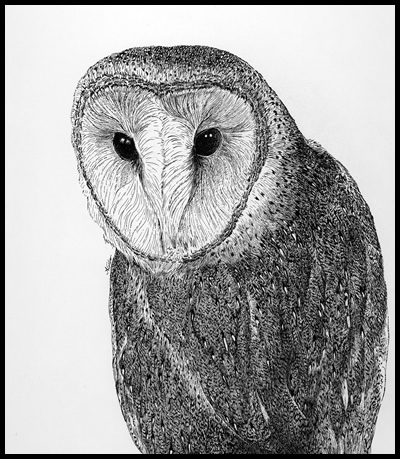| |
| |
| |
| |
| |
| |
| |
| |
| |
| |
| COMMON
BARN OWL |

|
| The barn owl dares
to be different. Look, for example, at its place in owl classification.
The owls of the world are divided into two families. One group is called
the "typical" owls, and most owls, some 123 species, are placed
in this family. The other family is made up only of barn owls and their
close relatives - ten species in all. There are eight species worldwide
that go by the name of barn owl, but only one species need concern us
here. That is Tyto alba, found on every continent but Antarctica,
and occurring in many subspecies. The single subspecies inhabiting North
America is Tyto alba pratincola. The North American
barn owl is found from the most southern parts of Canada down into Mexico.
It occurs from Washington through California in the West, and from southern
Vermont and Massachusetts down through Florida in the East. The barn owl is medium-large and unowlishly slender, with a streamlined look given it by unusually smooth plumage. The eyes are a dark mahogany brown and look comparatively small, very different from the huge brown eyes of the barred owl. It is the facial disc of this owl, however, that really sets it apart. The barn owl is sometimes called the monkey-faced owl, and indeed its white, uniquely heart-shaped face does give it an odd, mammal-like look. The beak is unusually long, as are the legs, which are scantily feathered on their lower half, and (another unique feature) knock-kneed. The upperparts of this owl are golden brown, while the underside is white, marked on the chest with delicate dark spots. The barn owl's fondness for roosting and nesting in man-made structures gives the bird its common name. It also accounts for many stories about "haunted" houses. In fact, the barn owl has several characteristics that can make it seem spooky. One is its voice. Because of the structure of its voice box, this owl cannot hoot. Its vocalizations are varied, though, ranging from hisses and snores to a particularly hair-raising shriek that the barn owl uses as a territorial call. Another spooky characteristic is the owl's ghostly-white look in the air. Equally eerie is its noiseless flight. This is made possible partly by the barn owl's incredibly soft plumage, and partly by its large wingspan compared to a small body weight (a 43- to 47-inch wingspan on a bird that averages only 15 1/2 ounces in weight). Supported on wide, soft-feathered wings, the barn owl hunts over open spaces, silently sneaking up on its prey. Prey is almost always a rodent such as a mouse, rat or vole. The owl seems to pinpoint its prey's whereabouts by using its extraordinarily sharp hearing just as much as its remarkable vision. The nocturnal barn owl is preyed upon by another nighttime hunter, the great horned owl. People-related problems like habitat destruction and pesticide poisoning, along with severe winter weather, have kept barn owl numbers low in the Northeast in recent years. |